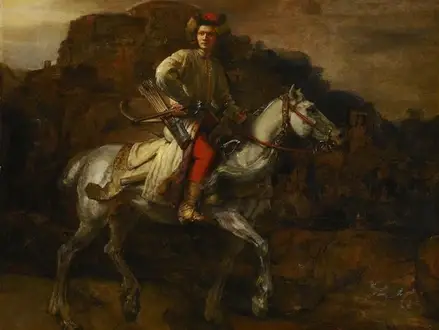Title of Artwork: “The Polish Rider”

Artwork by Rembrandt
Year Created 1655
Summary of The Polish Rider
The Polish Rider, a 17th-century painting depicting a young man riding a horse through a gloomy landscape and now housed in The Frick Collection in New York, is usually dated to the 1650s.
After Zdzisaw Tarnowski (pl) sold the painting to Henry Frick in 1910, the consensus was that Rembrandt had painted it. Although this attribution has since been contested, the minority view remains.
All About The Polish Rider
Whether or not the painting was intended to be a portrait of a specific person, living or historical, and if so of whom or what it was intended to represent, has also been a subject of discussion. Even though some parts of the background are very sketchily painted or unfinished, the painting’s quality and mystery are widely recognised.
According to Wilhelm von Bode in his History of Dutch Painting (1883), the painting is by Rembrandt from his “late” period, which means it was painted in the year 1654. When Abraham Bredius examined the painting, he was certain that Rembrandt was the artist.
Aert de Gelder, a student of Rembrandt, was suggested as the author by Alfred von Wurzbach at the beginning of the twentieth century, but his opinion was generally ignored. Even Julius S. Held, who at one time questioned the painting’s connection to Poland, never doubted Rembrandt’s authorship of the painting throughout most of the twentieth century.
A member of the Rembrandt Research Project (RRP) at the time, Josua Bruyn, speculated that the painting resembled the work of Rembrandt’s former student Willem Drost in 1984. Even though The Polish Rider’s mysterious and solemn expression is reminiscent of Rembrandt’s work, it differs from Rembrandt’s other works in other ways.
Only Rembrandt’s Portrait of Frederick Rihel, 1663, depicts an equestrian subject; he rarely painted horses in general (National Gallery, London).
In spite of the fact that Drost’s authorship is now widely accepted, the Frick never changed its own attribution to “Rembrandt” and never added “attributed to” or “school of” to the label.
There has been even more recent support for attribution to the master by scholars like Simon Schama in his book Rembrandt’s Eye in 1999 and Ernst van de Wetering, chair of the Rembrandt Project (Melbourne Symposium 1997).
Researchers who are sceptical about Rembrandt’s authorship claim that the work is inconsistently executed, leading them to favour various attributions. According to a 1998 study by the RRP, a second artist’s hand was involved in the painting. However, the painting may have been completed by someone else after Rembrandt started it in the 1650s.
Assuming the picture is a portrait, the idealised and enigmatic subject has spawned numerous theories. For the Oginski family, Marcjan Aleksander Ogiski, an ancestor of Polish-Lithuanian lineage, has been a contender, as has Jonasz Szlichtyng, an 18th-century Polish theologian.
Others believe that the rider’s clothing, weapons, and even the horse breed are all from Poland. ‘ Rembrandt’s Frederick Rihel, a 17th-century Dutch equestrian portrait, shows a well-dressed rider on a well-bred, spirited horse.
Information Citations
En.wikipedia.org, https://en.wikipedia.org/.
























